CMAC222 - Tennis Elbow: Western and Chinese Medicine
VerifiedAdded on 2020/10/22
|11
|3039
|402
Report
AI Summary
This report provides a comprehensive comparison of Western and Chinese medicine approaches to treating tennis elbow. It begins with an introduction to tennis elbow, its causes, and symptoms, followed by a background study. The report then delves into Western medicine's use of NSAIDs and Chinese medicine's practices, including acupuncture, herbal medicine, and massage. An in-depth analysis contrasts the philosophies, diagnostic methods, and treatment strategies of both medical systems. The report highlights the unique aspects of each approach, such as Western medicine's focus on pharmaceutical interventions and Chinese medicine's emphasis on holistic balance. Furthermore, the report discusses the benefits and potential drawbacks of each system, offering a balanced perspective on their respective strengths and limitations in managing tennis elbow. Finally, the report concludes by summarizing the key findings and emphasizing the value of understanding both medical perspectives for effective patient care.
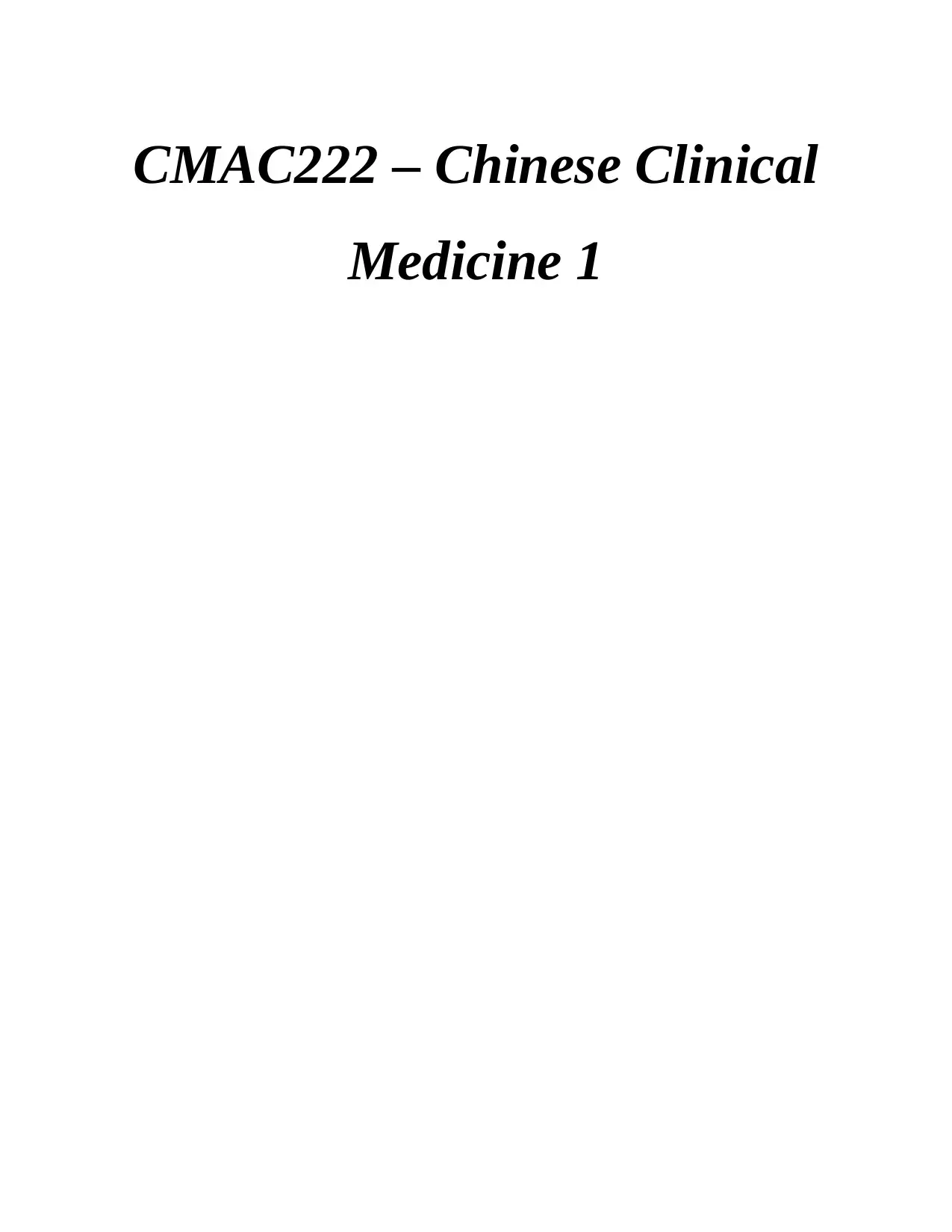
CMAC222 – Chinese Clinical
Medicine 1
Medicine 1
Paraphrase This Document
Need a fresh take? Get an instant paraphrase of this document with our AI Paraphraser
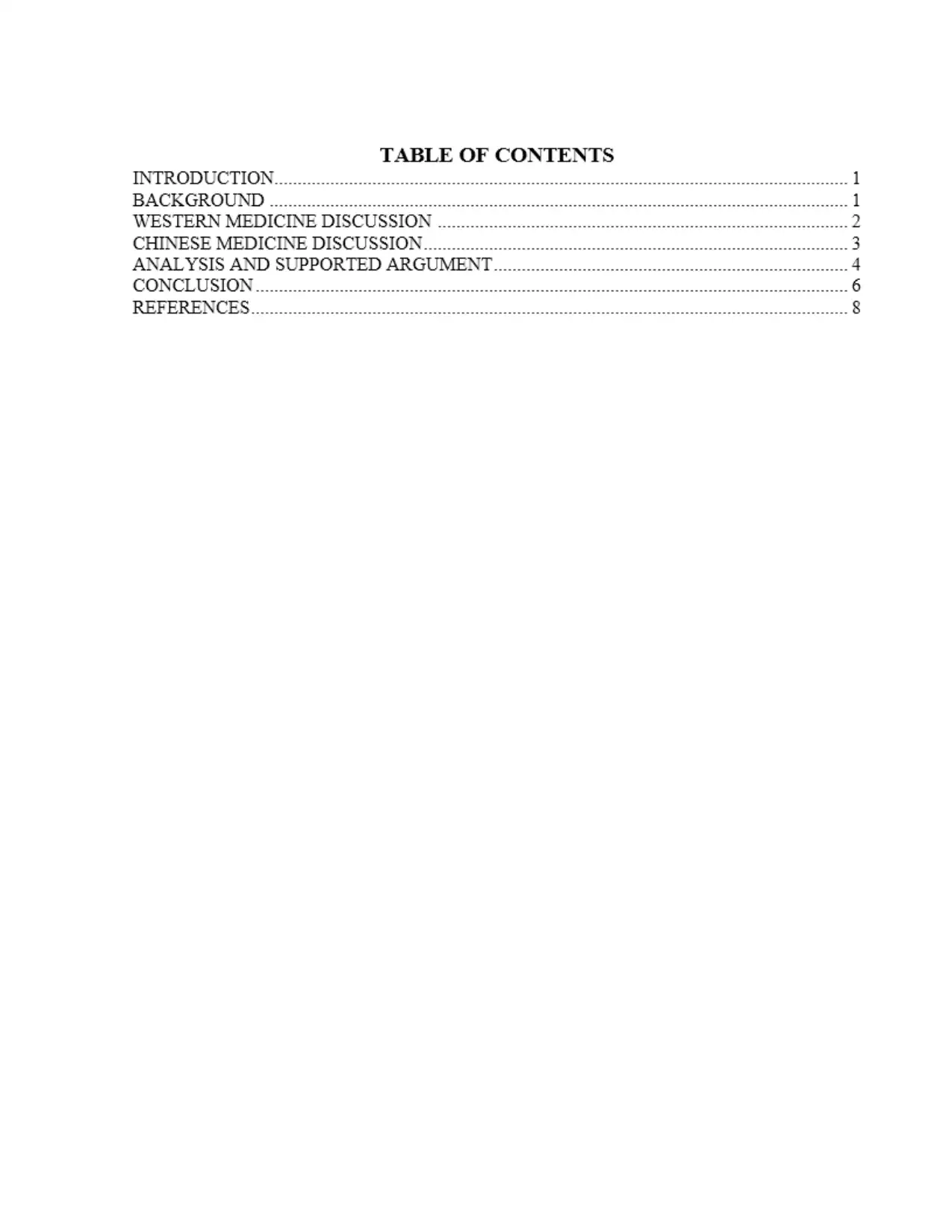
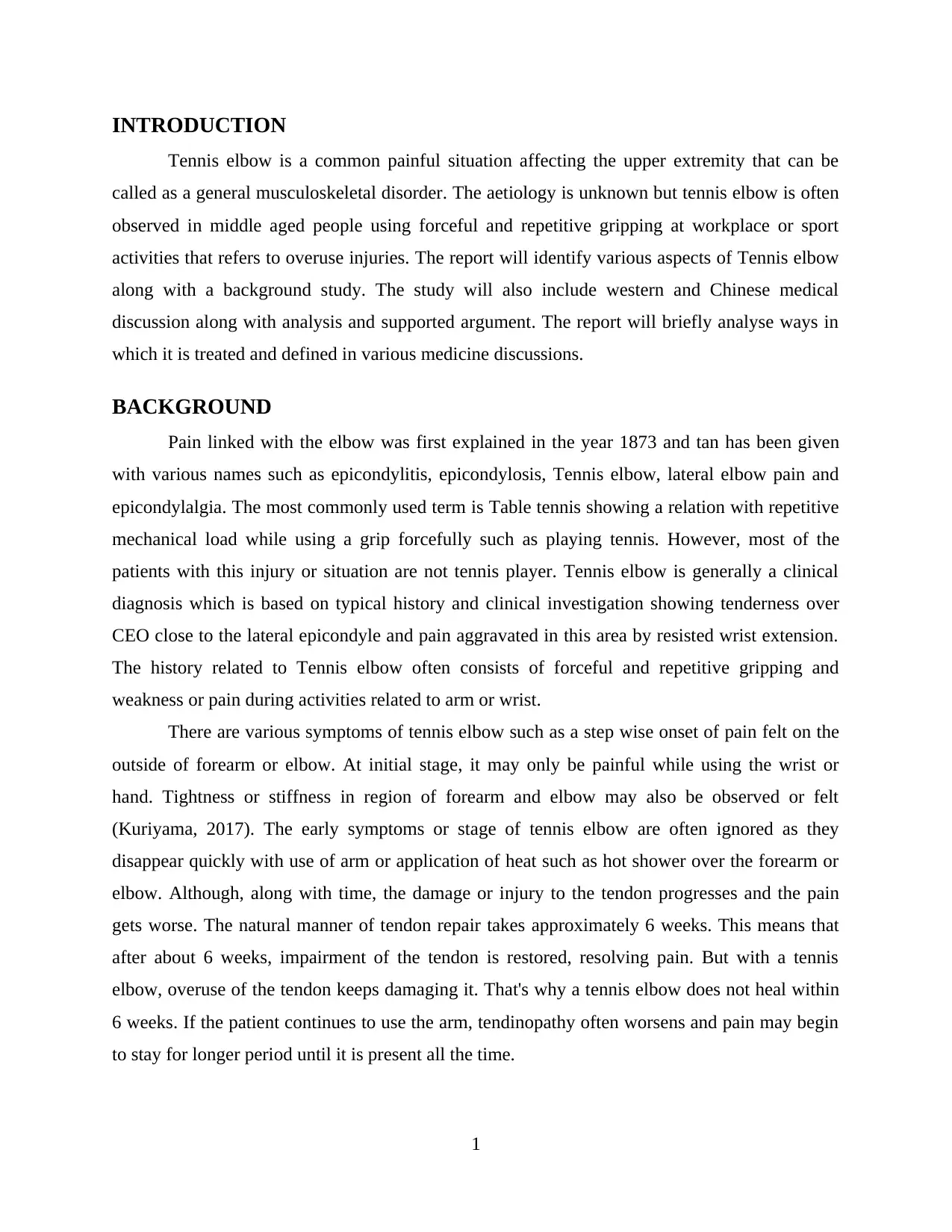
INTRODUCTION
Tennis elbow is a common painful situation affecting the upper extremity that can be
called as a general musculoskeletal disorder. The aetiology is unknown but tennis elbow is often
observed in middle aged people using forceful and repetitive gripping at workplace or sport
activities that refers to overuse injuries. The report will identify various aspects of Tennis elbow
along with a background study. The study will also include western and Chinese medical
discussion along with analysis and supported argument. The report will briefly analyse ways in
which it is treated and defined in various medicine discussions.
BACKGROUND
Pain linked with the elbow was first explained in the year 1873 and tan has been given
with various names such as epicondylitis, epicondylosis, Tennis elbow, lateral elbow pain and
epicondylalgia. The most commonly used term is Table tennis showing a relation with repetitive
mechanical load while using a grip forcefully such as playing tennis. However, most of the
patients with this injury or situation are not tennis player. Tennis elbow is generally a clinical
diagnosis which is based on typical history and clinical investigation showing tenderness over
CEO close to the lateral epicondyle and pain aggravated in this area by resisted wrist extension.
The history related to Tennis elbow often consists of forceful and repetitive gripping and
weakness or pain during activities related to arm or wrist.
There are various symptoms of tennis elbow such as a step wise onset of pain felt on the
outside of forearm or elbow. At initial stage, it may only be painful while using the wrist or
hand. Tightness or stiffness in region of forearm and elbow may also be observed or felt
(Kuriyama, 2017). The early symptoms or stage of tennis elbow are often ignored as they
disappear quickly with use of arm or application of heat such as hot shower over the forearm or
elbow. Although, along with time, the damage or injury to the tendon progresses and the pain
gets worse. The natural manner of tendon repair takes approximately 6 weeks. This means that
after about 6 weeks, impairment of the tendon is restored, resolving pain. But with a tennis
elbow, overuse of the tendon keeps damaging it. That's why a tennis elbow does not heal within
6 weeks. If the patient continues to use the arm, tendinopathy often worsens and pain may begin
to stay for longer period until it is present all the time.
1
Tennis elbow is a common painful situation affecting the upper extremity that can be
called as a general musculoskeletal disorder. The aetiology is unknown but tennis elbow is often
observed in middle aged people using forceful and repetitive gripping at workplace or sport
activities that refers to overuse injuries. The report will identify various aspects of Tennis elbow
along with a background study. The study will also include western and Chinese medical
discussion along with analysis and supported argument. The report will briefly analyse ways in
which it is treated and defined in various medicine discussions.
BACKGROUND
Pain linked with the elbow was first explained in the year 1873 and tan has been given
with various names such as epicondylitis, epicondylosis, Tennis elbow, lateral elbow pain and
epicondylalgia. The most commonly used term is Table tennis showing a relation with repetitive
mechanical load while using a grip forcefully such as playing tennis. However, most of the
patients with this injury or situation are not tennis player. Tennis elbow is generally a clinical
diagnosis which is based on typical history and clinical investigation showing tenderness over
CEO close to the lateral epicondyle and pain aggravated in this area by resisted wrist extension.
The history related to Tennis elbow often consists of forceful and repetitive gripping and
weakness or pain during activities related to arm or wrist.
There are various symptoms of tennis elbow such as a step wise onset of pain felt on the
outside of forearm or elbow. At initial stage, it may only be painful while using the wrist or
hand. Tightness or stiffness in region of forearm and elbow may also be observed or felt
(Kuriyama, 2017). The early symptoms or stage of tennis elbow are often ignored as they
disappear quickly with use of arm or application of heat such as hot shower over the forearm or
elbow. Although, along with time, the damage or injury to the tendon progresses and the pain
gets worse. The natural manner of tendon repair takes approximately 6 weeks. This means that
after about 6 weeks, impairment of the tendon is restored, resolving pain. But with a tennis
elbow, overuse of the tendon keeps damaging it. That's why a tennis elbow does not heal within
6 weeks. If the patient continues to use the arm, tendinopathy often worsens and pain may begin
to stay for longer period until it is present all the time.
1
⊘ This is a preview!⊘
Do you want full access?
Subscribe today to unlock all pages.

Trusted by 1+ million students worldwide
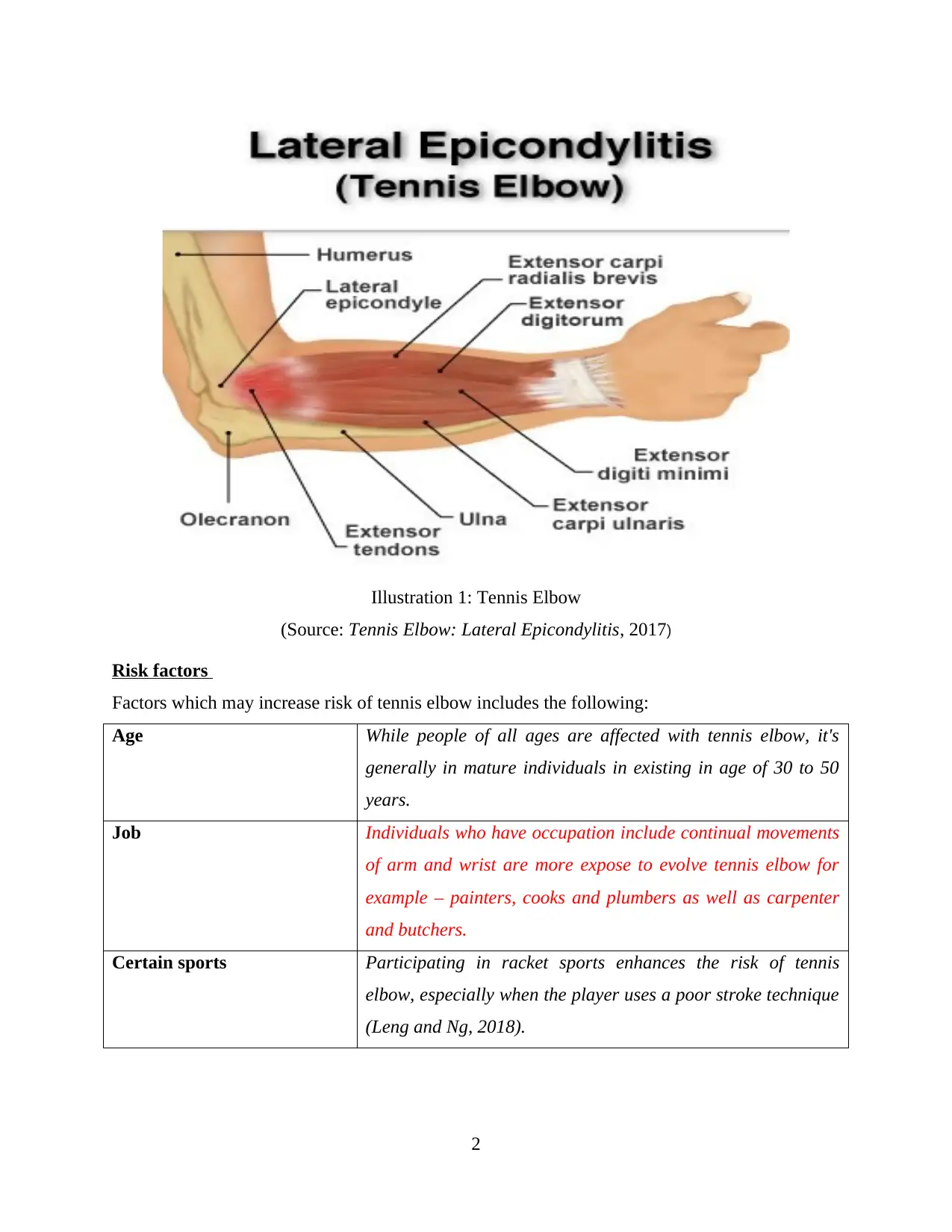
Risk factors
Factors which may increase risk of tennis elbow includes the following:
Age While people of all ages are affected with tennis elbow, it's
generally in mature individuals in existing in age of 30 to 50
years.
Job Individuals who have occupation include continual movements
of arm and wrist are more expose to evolve tennis elbow for
example – painters, cooks and plumbers as well as carpenter
and butchers.
Certain sports Participating in racket sports enhances the risk of tennis
elbow, especially when the player uses a poor stroke technique
(Leng and Ng, 2018).
2
Illustration 1: Tennis Elbow
(Source: Tennis Elbow: Lateral Epicondylitis, 2017)
Factors which may increase risk of tennis elbow includes the following:
Age While people of all ages are affected with tennis elbow, it's
generally in mature individuals in existing in age of 30 to 50
years.
Job Individuals who have occupation include continual movements
of arm and wrist are more expose to evolve tennis elbow for
example – painters, cooks and plumbers as well as carpenter
and butchers.
Certain sports Participating in racket sports enhances the risk of tennis
elbow, especially when the player uses a poor stroke technique
(Leng and Ng, 2018).
2
Illustration 1: Tennis Elbow
(Source: Tennis Elbow: Lateral Epicondylitis, 2017)
Paraphrase This Document
Need a fresh take? Get an instant paraphrase of this document with our AI Paraphraser
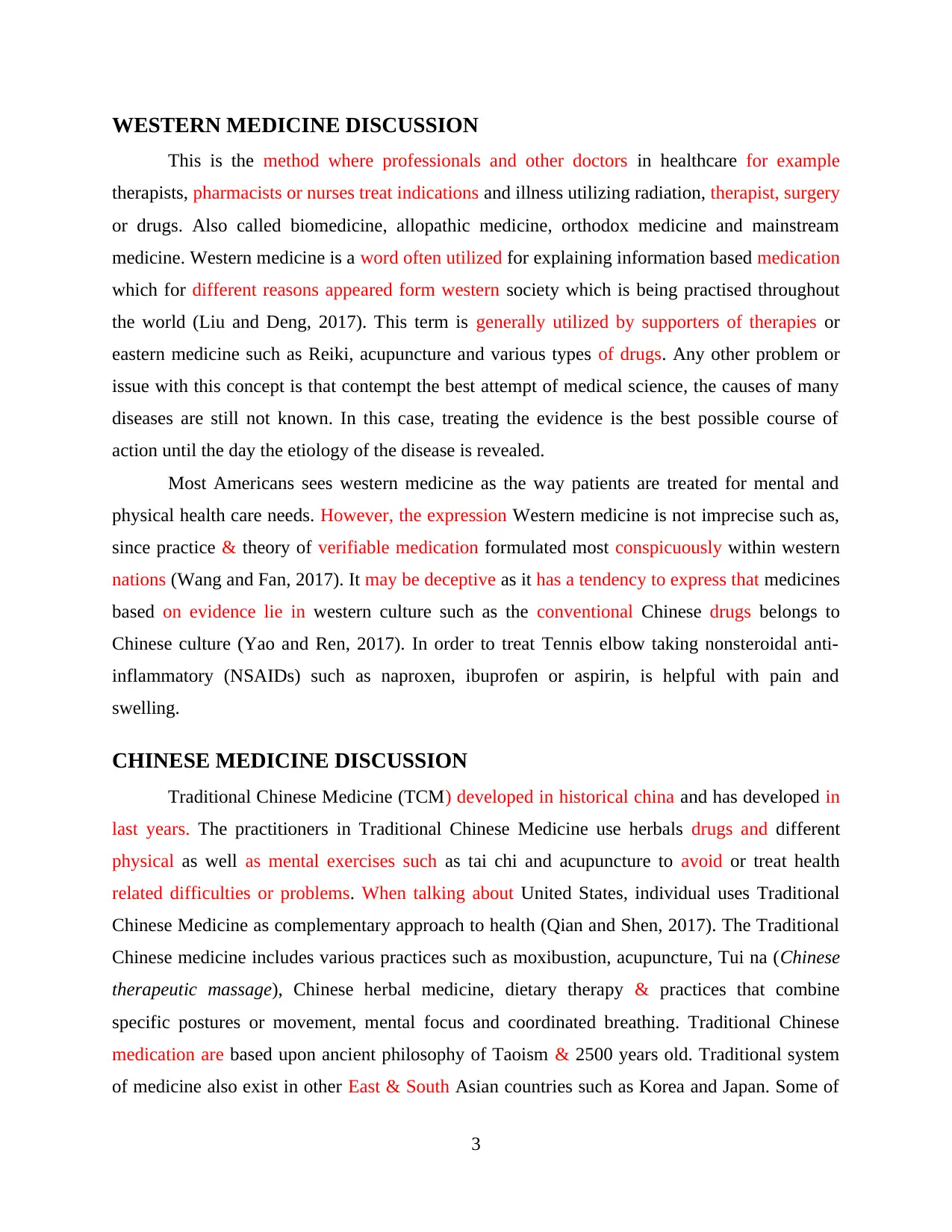
WESTERN MEDICINE DISCUSSION
This is the method where professionals and other doctors in healthcare for example
therapists, pharmacists or nurses treat indications and illness utilizing radiation, therapist, surgery
or drugs. Also called biomedicine, allopathic medicine, orthodox medicine and mainstream
medicine. Western medicine is a word often utilized for explaining information based medication
which for different reasons appeared form western society which is being practised throughout
the world (Liu and Deng, 2017). This term is generally utilized by supporters of therapies or
eastern medicine such as Reiki, acupuncture and various types of drugs. Any other problem or
issue with this concept is that contempt the best attempt of medical science, the causes of many
diseases are still not known. In this case, treating the evidence is the best possible course of
action until the day the etiology of the disease is revealed.
Most Americans sees western medicine as the way patients are treated for mental and
physical health care needs. However, the expression Western medicine is not imprecise such as,
since practice & theory of verifiable medication formulated most conspicuously within western
nations (Wang and Fan, 2017). It may be deceptive as it has a tendency to express that medicines
based on evidence lie in western culture such as the conventional Chinese drugs belongs to
Chinese culture (Yao and Ren, 2017). In order to treat Tennis elbow taking nonsteroidal anti-
inflammatory (NSAIDs) such as naproxen, ibuprofen or aspirin, is helpful with pain and
swelling.
CHINESE MEDICINE DISCUSSION
Traditional Chinese Medicine (TCM) developed in historical china and has developed in
last years. The practitioners in Traditional Chinese Medicine use herbals drugs and different
physical as well as mental exercises such as tai chi and acupuncture to avoid or treat health
related difficulties or problems. When talking about United States, individual uses Traditional
Chinese Medicine as complementary approach to health (Qian and Shen, 2017). The Traditional
Chinese medicine includes various practices such as moxibustion, acupuncture, Tui na (Chinese
therapeutic massage), Chinese herbal medicine, dietary therapy & practices that combine
specific postures or movement, mental focus and coordinated breathing. Traditional Chinese
medication are based upon ancient philosophy of Taoism & 2500 years old. Traditional system
of medicine also exist in other East & South Asian countries such as Korea and Japan. Some of
3
This is the method where professionals and other doctors in healthcare for example
therapists, pharmacists or nurses treat indications and illness utilizing radiation, therapist, surgery
or drugs. Also called biomedicine, allopathic medicine, orthodox medicine and mainstream
medicine. Western medicine is a word often utilized for explaining information based medication
which for different reasons appeared form western society which is being practised throughout
the world (Liu and Deng, 2017). This term is generally utilized by supporters of therapies or
eastern medicine such as Reiki, acupuncture and various types of drugs. Any other problem or
issue with this concept is that contempt the best attempt of medical science, the causes of many
diseases are still not known. In this case, treating the evidence is the best possible course of
action until the day the etiology of the disease is revealed.
Most Americans sees western medicine as the way patients are treated for mental and
physical health care needs. However, the expression Western medicine is not imprecise such as,
since practice & theory of verifiable medication formulated most conspicuously within western
nations (Wang and Fan, 2017). It may be deceptive as it has a tendency to express that medicines
based on evidence lie in western culture such as the conventional Chinese drugs belongs to
Chinese culture (Yao and Ren, 2017). In order to treat Tennis elbow taking nonsteroidal anti-
inflammatory (NSAIDs) such as naproxen, ibuprofen or aspirin, is helpful with pain and
swelling.
CHINESE MEDICINE DISCUSSION
Traditional Chinese Medicine (TCM) developed in historical china and has developed in
last years. The practitioners in Traditional Chinese Medicine use herbals drugs and different
physical as well as mental exercises such as tai chi and acupuncture to avoid or treat health
related difficulties or problems. When talking about United States, individual uses Traditional
Chinese Medicine as complementary approach to health (Qian and Shen, 2017). The Traditional
Chinese medicine includes various practices such as moxibustion, acupuncture, Tui na (Chinese
therapeutic massage), Chinese herbal medicine, dietary therapy & practices that combine
specific postures or movement, mental focus and coordinated breathing. Traditional Chinese
medication are based upon ancient philosophy of Taoism & 2500 years old. Traditional system
of medicine also exist in other East & South Asian countries such as Korea and Japan. Some of
3
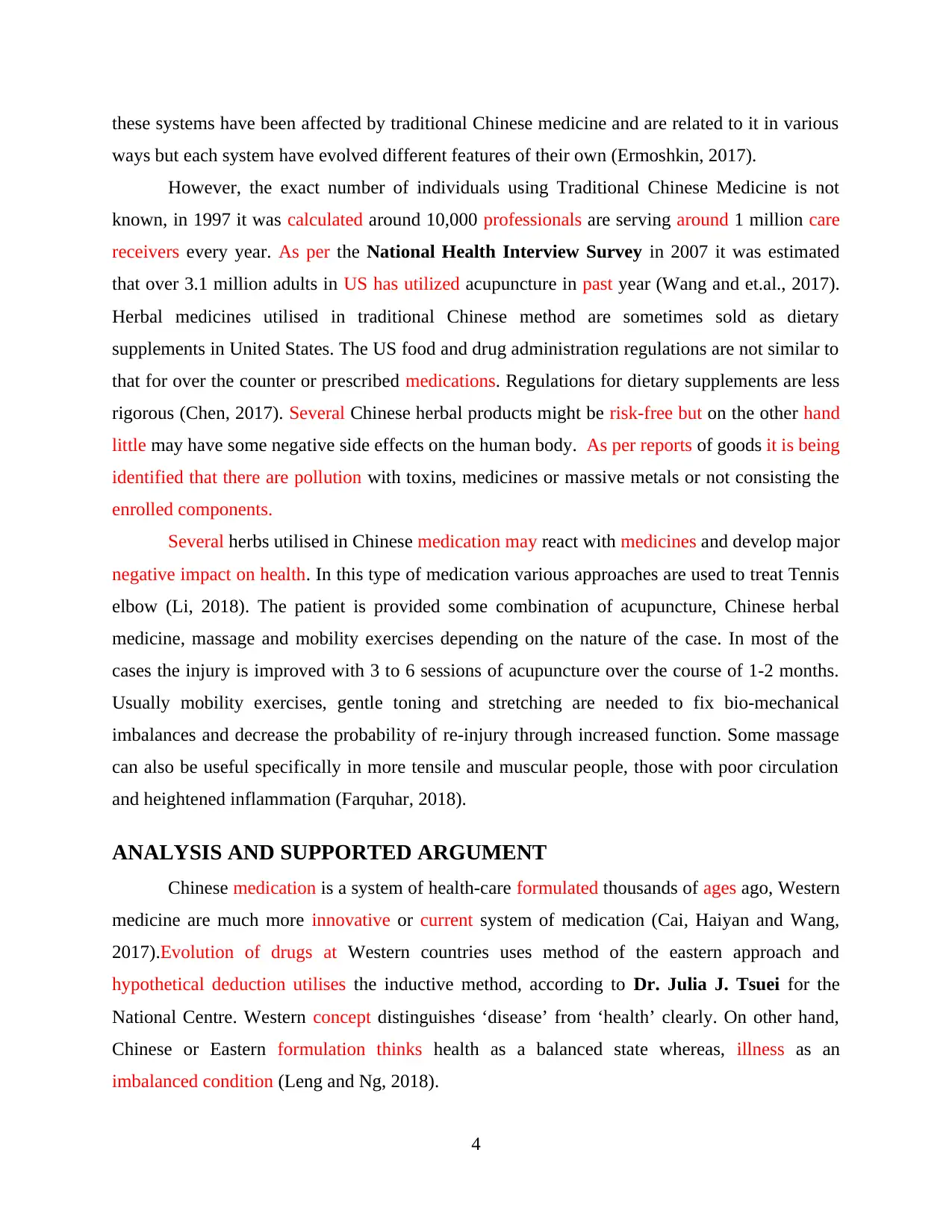
these systems have been affected by traditional Chinese medicine and are related to it in various
ways but each system have evolved different features of their own (Ermoshkin, 2017).
However, the exact number of individuals using Traditional Chinese Medicine is not
known, in 1997 it was calculated around 10,000 professionals are serving around 1 million care
receivers every year. As per the National Health Interview Survey in 2007 it was estimated
that over 3.1 million adults in US has utilized acupuncture in past year (Wang and et.al., 2017).
Herbal medicines utilised in traditional Chinese method are sometimes sold as dietary
supplements in United States. The US food and drug administration regulations are not similar to
that for over the counter or prescribed medications. Regulations for dietary supplements are less
rigorous (Chen, 2017). Several Chinese herbal products might be risk-free but on the other hand
little may have some negative side effects on the human body. As per reports of goods it is being
identified that there are pollution with toxins, medicines or massive metals or not consisting the
enrolled components.
Several herbs utilised in Chinese medication may react with medicines and develop major
negative impact on health. In this type of medication various approaches are used to treat Tennis
elbow (Li, 2018). The patient is provided some combination of acupuncture, Chinese herbal
medicine, massage and mobility exercises depending on the nature of the case. In most of the
cases the injury is improved with 3 to 6 sessions of acupuncture over the course of 1-2 months.
Usually mobility exercises, gentle toning and stretching are needed to fix bio-mechanical
imbalances and decrease the probability of re-injury through increased function. Some massage
can also be useful specifically in more tensile and muscular people, those with poor circulation
and heightened inflammation (Farquhar, 2018).
ANALYSIS AND SUPPORTED ARGUMENT
Chinese medication is a system of health-care formulated thousands of ages ago, Western
medicine are much more innovative or current system of medication (Cai, Haiyan and Wang,
2017).Evolution of drugs at Western countries uses method of the eastern approach and
hypothetical deduction utilises the inductive method, according to Dr. Julia J. Tsuei for the
National Centre. Western concept distinguishes ‘disease’ from ‘health’ clearly. On other hand,
Chinese or Eastern formulation thinks health as a balanced state whereas, illness as an
imbalanced condition (Leng and Ng, 2018).
4
ways but each system have evolved different features of their own (Ermoshkin, 2017).
However, the exact number of individuals using Traditional Chinese Medicine is not
known, in 1997 it was calculated around 10,000 professionals are serving around 1 million care
receivers every year. As per the National Health Interview Survey in 2007 it was estimated
that over 3.1 million adults in US has utilized acupuncture in past year (Wang and et.al., 2017).
Herbal medicines utilised in traditional Chinese method are sometimes sold as dietary
supplements in United States. The US food and drug administration regulations are not similar to
that for over the counter or prescribed medications. Regulations for dietary supplements are less
rigorous (Chen, 2017). Several Chinese herbal products might be risk-free but on the other hand
little may have some negative side effects on the human body. As per reports of goods it is being
identified that there are pollution with toxins, medicines or massive metals or not consisting the
enrolled components.
Several herbs utilised in Chinese medication may react with medicines and develop major
negative impact on health. In this type of medication various approaches are used to treat Tennis
elbow (Li, 2018). The patient is provided some combination of acupuncture, Chinese herbal
medicine, massage and mobility exercises depending on the nature of the case. In most of the
cases the injury is improved with 3 to 6 sessions of acupuncture over the course of 1-2 months.
Usually mobility exercises, gentle toning and stretching are needed to fix bio-mechanical
imbalances and decrease the probability of re-injury through increased function. Some massage
can also be useful specifically in more tensile and muscular people, those with poor circulation
and heightened inflammation (Farquhar, 2018).
ANALYSIS AND SUPPORTED ARGUMENT
Chinese medication is a system of health-care formulated thousands of ages ago, Western
medicine are much more innovative or current system of medication (Cai, Haiyan and Wang,
2017).Evolution of drugs at Western countries uses method of the eastern approach and
hypothetical deduction utilises the inductive method, according to Dr. Julia J. Tsuei for the
National Centre. Western concept distinguishes ‘disease’ from ‘health’ clearly. On other hand,
Chinese or Eastern formulation thinks health as a balanced state whereas, illness as an
imbalanced condition (Leng and Ng, 2018).
4
⊘ This is a preview!⊘
Do you want full access?
Subscribe today to unlock all pages.

Trusted by 1+ million students worldwide
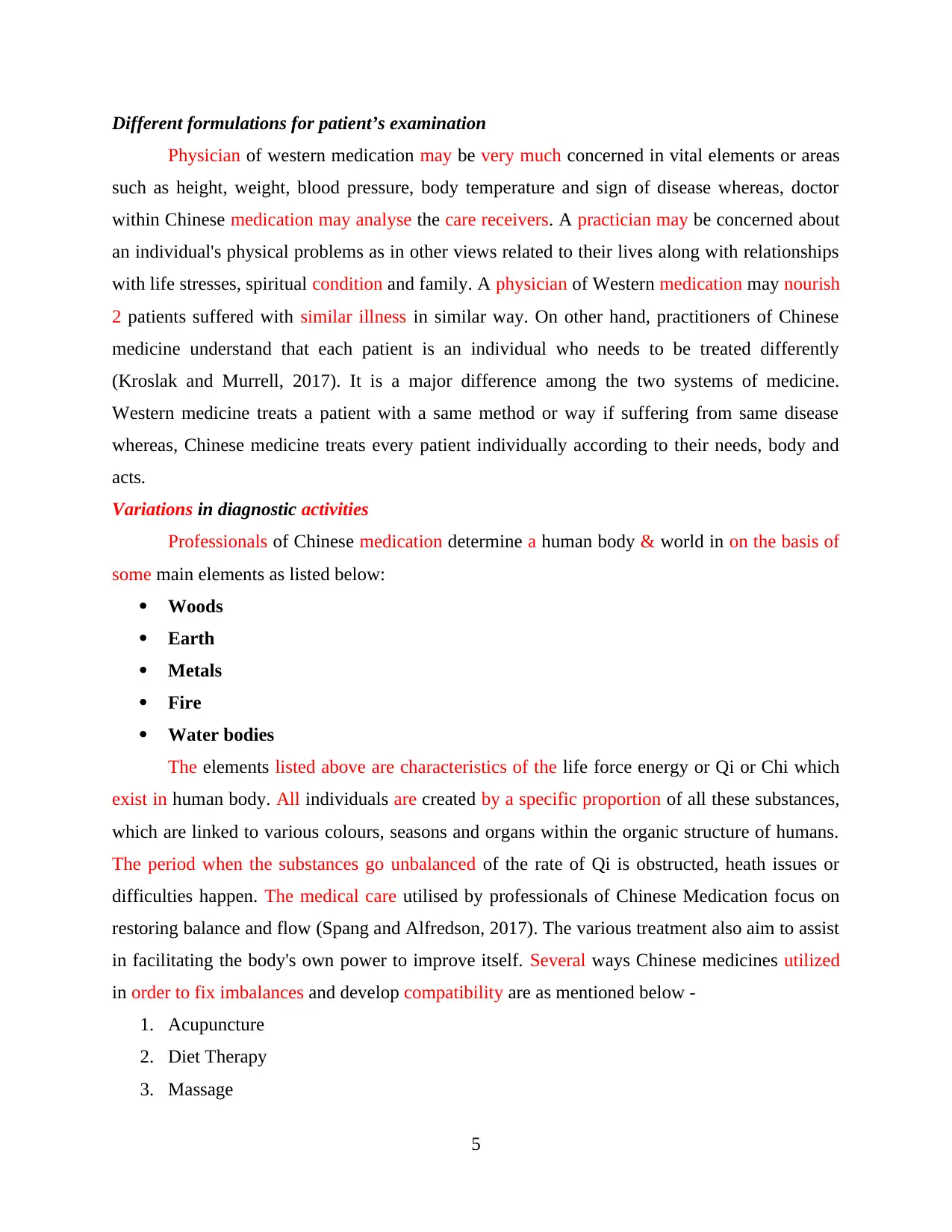
Different formulations for patient’s examination
Physician of western medication may be very much concerned in vital elements or areas
such as height, weight, blood pressure, body temperature and sign of disease whereas, doctor
within Chinese medication may analyse the care receivers. A practician may be concerned about
an individual's physical problems as in other views related to their lives along with relationships
with life stresses, spiritual condition and family. A physician of Western medication may nourish
2 patients suffered with similar illness in similar way. On other hand, practitioners of Chinese
medicine understand that each patient is an individual who needs to be treated differently
(Kroslak and Murrell, 2017). It is a major difference among the two systems of medicine.
Western medicine treats a patient with a same method or way if suffering from same disease
whereas, Chinese medicine treats every patient individually according to their needs, body and
acts.
Variations in diagnostic activities
Professionals of Chinese medication determine a human body & world in on the basis of
some main elements as listed below:
Woods
Earth
Metals
Fire
Water bodies
The elements listed above are characteristics of the life force energy or Qi or Chi which
exist in human body. All individuals are created by a specific proportion of all these substances,
which are linked to various colours, seasons and organs within the organic structure of humans.
The period when the substances go unbalanced of the rate of Qi is obstructed, heath issues or
difficulties happen. The medical care utilised by professionals of Chinese Medication focus on
restoring balance and flow (Spang and Alfredson, 2017). The various treatment also aim to assist
in facilitating the body's own power to improve itself. Several ways Chinese medicines utilized
in order to fix imbalances and develop compatibility are as mentioned below -
1. Acupuncture
2. Diet Therapy
3. Massage
5
Physician of western medication may be very much concerned in vital elements or areas
such as height, weight, blood pressure, body temperature and sign of disease whereas, doctor
within Chinese medication may analyse the care receivers. A practician may be concerned about
an individual's physical problems as in other views related to their lives along with relationships
with life stresses, spiritual condition and family. A physician of Western medication may nourish
2 patients suffered with similar illness in similar way. On other hand, practitioners of Chinese
medicine understand that each patient is an individual who needs to be treated differently
(Kroslak and Murrell, 2017). It is a major difference among the two systems of medicine.
Western medicine treats a patient with a same method or way if suffering from same disease
whereas, Chinese medicine treats every patient individually according to their needs, body and
acts.
Variations in diagnostic activities
Professionals of Chinese medication determine a human body & world in on the basis of
some main elements as listed below:
Woods
Earth
Metals
Fire
Water bodies
The elements listed above are characteristics of the life force energy or Qi or Chi which
exist in human body. All individuals are created by a specific proportion of all these substances,
which are linked to various colours, seasons and organs within the organic structure of humans.
The period when the substances go unbalanced of the rate of Qi is obstructed, heath issues or
difficulties happen. The medical care utilised by professionals of Chinese Medication focus on
restoring balance and flow (Spang and Alfredson, 2017). The various treatment also aim to assist
in facilitating the body's own power to improve itself. Several ways Chinese medicines utilized
in order to fix imbalances and develop compatibility are as mentioned below -
1. Acupuncture
2. Diet Therapy
3. Massage
5
Paraphrase This Document
Need a fresh take? Get an instant paraphrase of this document with our AI Paraphraser
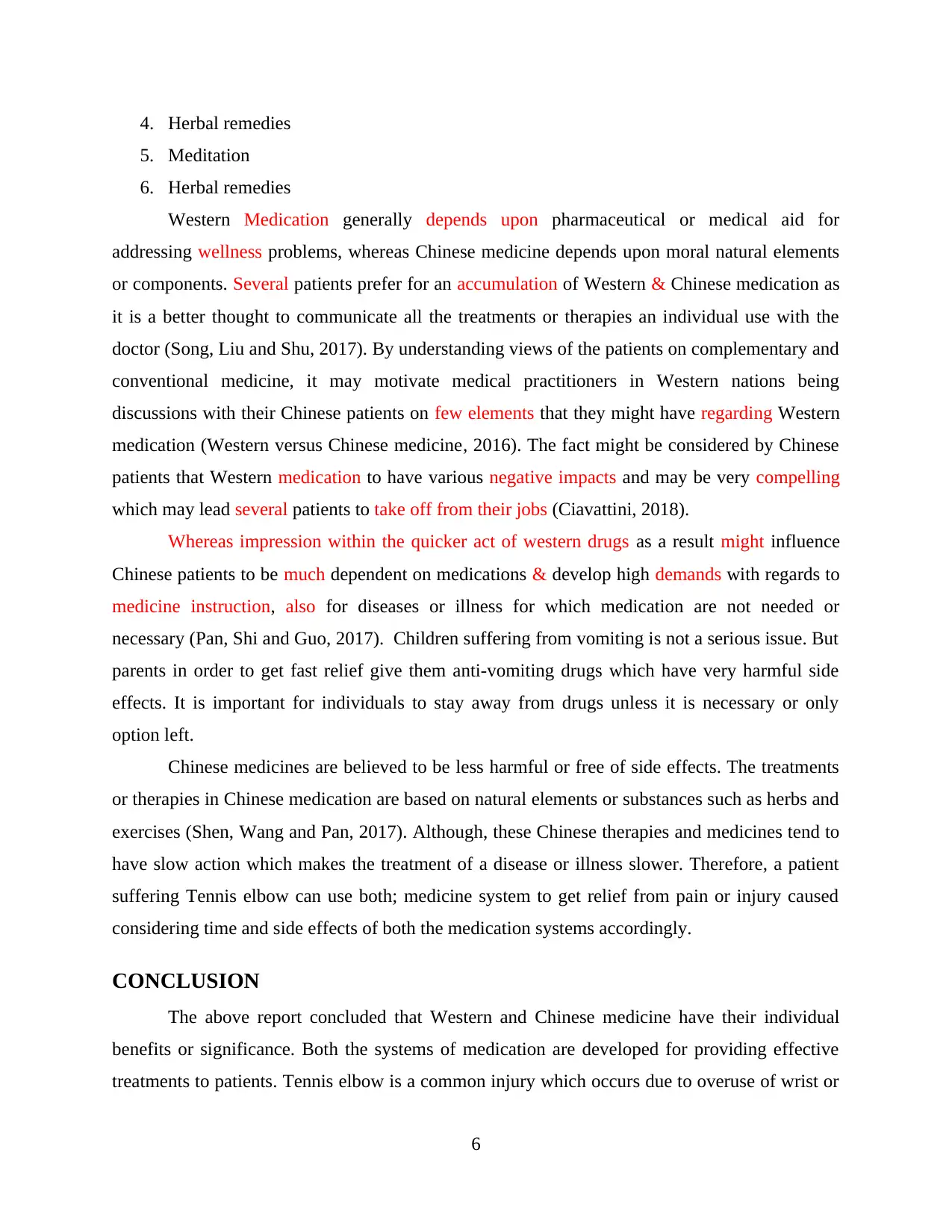
4. Herbal remedies
5. Meditation
6. Herbal remedies
Western Medication generally depends upon pharmaceutical or medical aid for
addressing wellness problems, whereas Chinese medicine depends upon moral natural elements
or components. Several patients prefer for an accumulation of Western & Chinese medication as
it is a better thought to communicate all the treatments or therapies an individual use with the
doctor (Song, Liu and Shu, 2017). By understanding views of the patients on complementary and
conventional medicine, it may motivate medical practitioners in Western nations being
discussions with their Chinese patients on few elements that they might have regarding Western
medication (Western versus Chinese medicine, 2016). The fact might be considered by Chinese
patients that Western medication to have various negative impacts and may be very compelling
which may lead several patients to take off from their jobs (Ciavattini, 2018).
Whereas impression within the quicker act of western drugs as a result might influence
Chinese patients to be much dependent on medications & develop high demands with regards to
medicine instruction, also for diseases or illness for which medication are not needed or
necessary (Pan, Shi and Guo, 2017). Children suffering from vomiting is not a serious issue. But
parents in order to get fast relief give them anti-vomiting drugs which have very harmful side
effects. It is important for individuals to stay away from drugs unless it is necessary or only
option left.
Chinese medicines are believed to be less harmful or free of side effects. The treatments
or therapies in Chinese medication are based on natural elements or substances such as herbs and
exercises (Shen, Wang and Pan, 2017). Although, these Chinese therapies and medicines tend to
have slow action which makes the treatment of a disease or illness slower. Therefore, a patient
suffering Tennis elbow can use both; medicine system to get relief from pain or injury caused
considering time and side effects of both the medication systems accordingly.
CONCLUSION
The above report concluded that Western and Chinese medicine have their individual
benefits or significance. Both the systems of medication are developed for providing effective
treatments to patients. Tennis elbow is a common injury which occurs due to overuse of wrist or
6
5. Meditation
6. Herbal remedies
Western Medication generally depends upon pharmaceutical or medical aid for
addressing wellness problems, whereas Chinese medicine depends upon moral natural elements
or components. Several patients prefer for an accumulation of Western & Chinese medication as
it is a better thought to communicate all the treatments or therapies an individual use with the
doctor (Song, Liu and Shu, 2017). By understanding views of the patients on complementary and
conventional medicine, it may motivate medical practitioners in Western nations being
discussions with their Chinese patients on few elements that they might have regarding Western
medication (Western versus Chinese medicine, 2016). The fact might be considered by Chinese
patients that Western medication to have various negative impacts and may be very compelling
which may lead several patients to take off from their jobs (Ciavattini, 2018).
Whereas impression within the quicker act of western drugs as a result might influence
Chinese patients to be much dependent on medications & develop high demands with regards to
medicine instruction, also for diseases or illness for which medication are not needed or
necessary (Pan, Shi and Guo, 2017). Children suffering from vomiting is not a serious issue. But
parents in order to get fast relief give them anti-vomiting drugs which have very harmful side
effects. It is important for individuals to stay away from drugs unless it is necessary or only
option left.
Chinese medicines are believed to be less harmful or free of side effects. The treatments
or therapies in Chinese medication are based on natural elements or substances such as herbs and
exercises (Shen, Wang and Pan, 2017). Although, these Chinese therapies and medicines tend to
have slow action which makes the treatment of a disease or illness slower. Therefore, a patient
suffering Tennis elbow can use both; medicine system to get relief from pain or injury caused
considering time and side effects of both the medication systems accordingly.
CONCLUSION
The above report concluded that Western and Chinese medicine have their individual
benefits or significance. Both the systems of medication are developed for providing effective
treatments to patients. Tennis elbow is a common injury which occurs due to overuse of wrist or
6
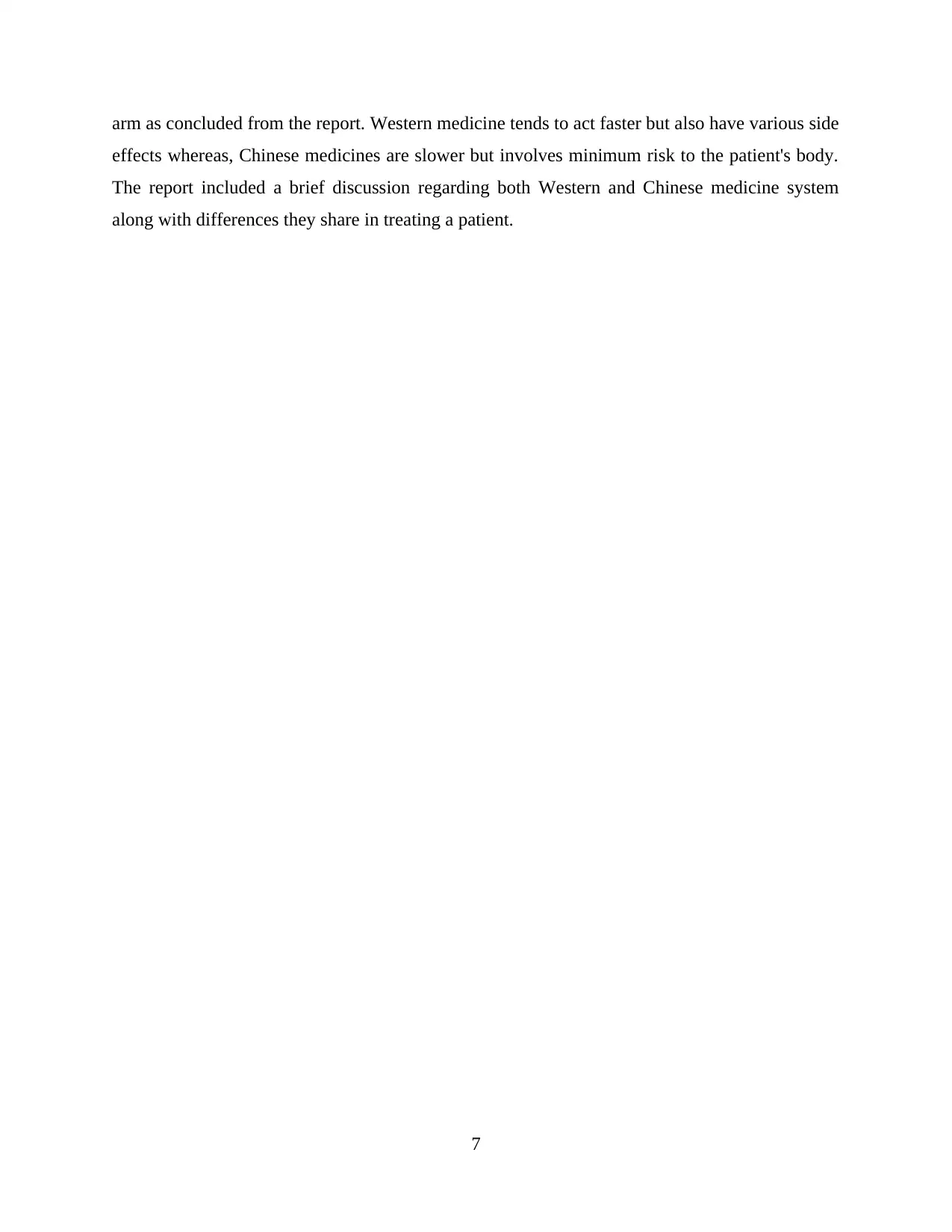
arm as concluded from the report. Western medicine tends to act faster but also have various side
effects whereas, Chinese medicines are slower but involves minimum risk to the patient's body.
The report included a brief discussion regarding both Western and Chinese medicine system
along with differences they share in treating a patient.
7
effects whereas, Chinese medicines are slower but involves minimum risk to the patient's body.
The report included a brief discussion regarding both Western and Chinese medicine system
along with differences they share in treating a patient.
7
⊘ This is a preview!⊘
Do you want full access?
Subscribe today to unlock all pages.

Trusted by 1+ million students worldwide
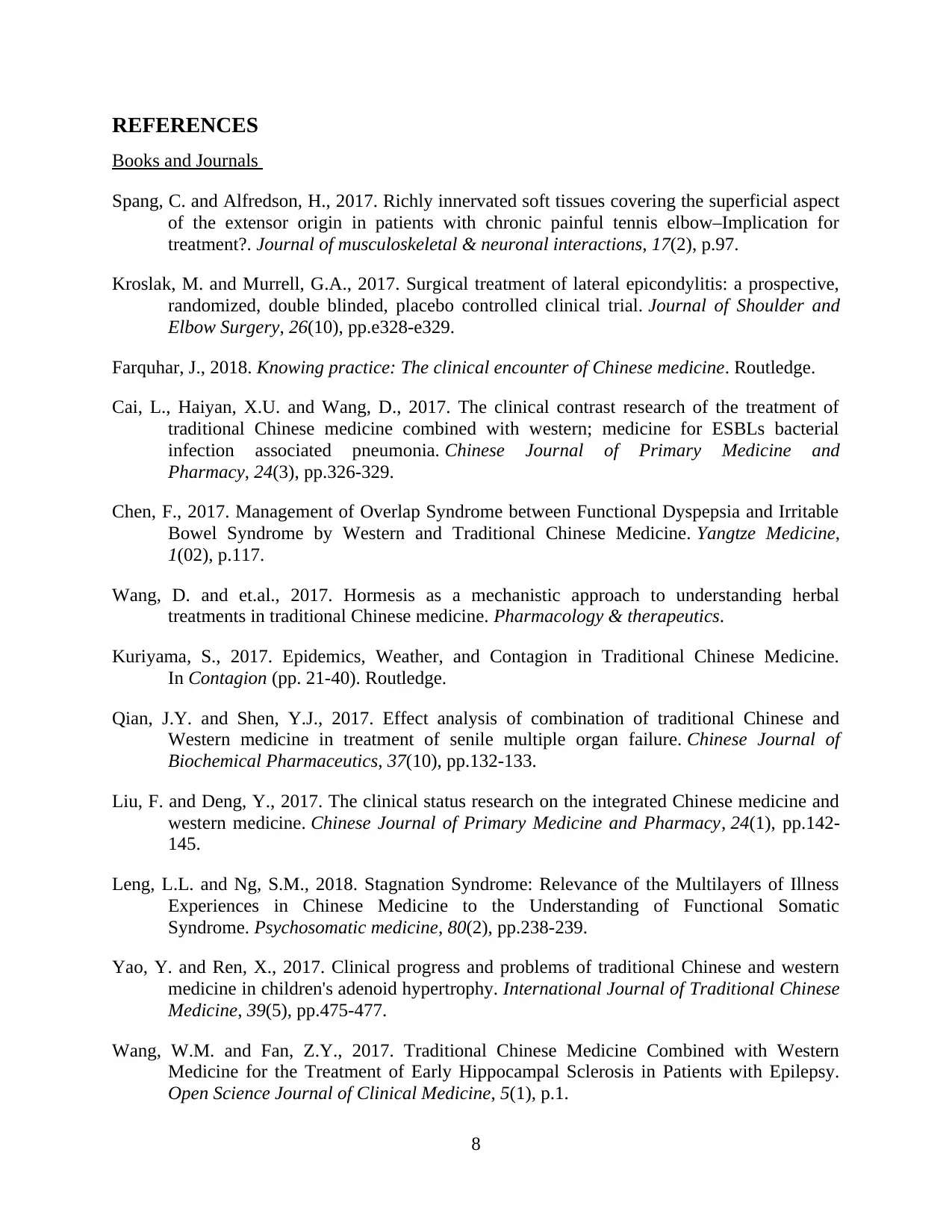
REFERENCES
Books and Journals
Spang, C. and Alfredson, H., 2017. Richly innervated soft tissues covering the superficial aspect
of the extensor origin in patients with chronic painful tennis elbow–Implication for
treatment?. Journal of musculoskeletal & neuronal interactions, 17(2), p.97.
Kroslak, M. and Murrell, G.A., 2017. Surgical treatment of lateral epicondylitis: a prospective,
randomized, double blinded, placebo controlled clinical trial. Journal of Shoulder and
Elbow Surgery, 26(10), pp.e328-e329.
Farquhar, J., 2018. Knowing practice: The clinical encounter of Chinese medicine. Routledge.
Cai, L., Haiyan, X.U. and Wang, D., 2017. The clinical contrast research of the treatment of
traditional Chinese medicine combined with western; medicine for ESBLs bacterial
infection associated pneumonia. Chinese Journal of Primary Medicine and
Pharmacy, 24(3), pp.326-329.
Chen, F., 2017. Management of Overlap Syndrome between Functional Dyspepsia and Irritable
Bowel Syndrome by Western and Traditional Chinese Medicine. Yangtze Medicine,
1(02), p.117.
Wang, D. and et.al., 2017. Hormesis as a mechanistic approach to understanding herbal
treatments in traditional Chinese medicine. Pharmacology & therapeutics.
Kuriyama, S., 2017. Epidemics, Weather, and Contagion in Traditional Chinese Medicine.
In Contagion (pp. 21-40). Routledge.
Qian, J.Y. and Shen, Y.J., 2017. Effect analysis of combination of traditional Chinese and
Western medicine in treatment of senile multiple organ failure. Chinese Journal of
Biochemical Pharmaceutics, 37(10), pp.132-133.
Liu, F. and Deng, Y., 2017. The clinical status research on the integrated Chinese medicine and
western medicine. Chinese Journal of Primary Medicine and Pharmacy, 24(1), pp.142-
145.
Leng, L.L. and Ng, S.M., 2018. Stagnation Syndrome: Relevance of the Multilayers of Illness
Experiences in Chinese Medicine to the Understanding of Functional Somatic
Syndrome. Psychosomatic medicine, 80(2), pp.238-239.
Yao, Y. and Ren, X., 2017. Clinical progress and problems of traditional Chinese and western
medicine in children's adenoid hypertrophy. International Journal of Traditional Chinese
Medicine, 39(5), pp.475-477.
Wang, W.M. and Fan, Z.Y., 2017. Traditional Chinese Medicine Combined with Western
Medicine for the Treatment of Early Hippocampal Sclerosis in Patients with Epilepsy.
Open Science Journal of Clinical Medicine, 5(1), p.1.
8
Books and Journals
Spang, C. and Alfredson, H., 2017. Richly innervated soft tissues covering the superficial aspect
of the extensor origin in patients with chronic painful tennis elbow–Implication for
treatment?. Journal of musculoskeletal & neuronal interactions, 17(2), p.97.
Kroslak, M. and Murrell, G.A., 2017. Surgical treatment of lateral epicondylitis: a prospective,
randomized, double blinded, placebo controlled clinical trial. Journal of Shoulder and
Elbow Surgery, 26(10), pp.e328-e329.
Farquhar, J., 2018. Knowing practice: The clinical encounter of Chinese medicine. Routledge.
Cai, L., Haiyan, X.U. and Wang, D., 2017. The clinical contrast research of the treatment of
traditional Chinese medicine combined with western; medicine for ESBLs bacterial
infection associated pneumonia. Chinese Journal of Primary Medicine and
Pharmacy, 24(3), pp.326-329.
Chen, F., 2017. Management of Overlap Syndrome between Functional Dyspepsia and Irritable
Bowel Syndrome by Western and Traditional Chinese Medicine. Yangtze Medicine,
1(02), p.117.
Wang, D. and et.al., 2017. Hormesis as a mechanistic approach to understanding herbal
treatments in traditional Chinese medicine. Pharmacology & therapeutics.
Kuriyama, S., 2017. Epidemics, Weather, and Contagion in Traditional Chinese Medicine.
In Contagion (pp. 21-40). Routledge.
Qian, J.Y. and Shen, Y.J., 2017. Effect analysis of combination of traditional Chinese and
Western medicine in treatment of senile multiple organ failure. Chinese Journal of
Biochemical Pharmaceutics, 37(10), pp.132-133.
Liu, F. and Deng, Y., 2017. The clinical status research on the integrated Chinese medicine and
western medicine. Chinese Journal of Primary Medicine and Pharmacy, 24(1), pp.142-
145.
Leng, L.L. and Ng, S.M., 2018. Stagnation Syndrome: Relevance of the Multilayers of Illness
Experiences in Chinese Medicine to the Understanding of Functional Somatic
Syndrome. Psychosomatic medicine, 80(2), pp.238-239.
Yao, Y. and Ren, X., 2017. Clinical progress and problems of traditional Chinese and western
medicine in children's adenoid hypertrophy. International Journal of Traditional Chinese
Medicine, 39(5), pp.475-477.
Wang, W.M. and Fan, Z.Y., 2017. Traditional Chinese Medicine Combined with Western
Medicine for the Treatment of Early Hippocampal Sclerosis in Patients with Epilepsy.
Open Science Journal of Clinical Medicine, 5(1), p.1.
8
Paraphrase This Document
Need a fresh take? Get an instant paraphrase of this document with our AI Paraphraser
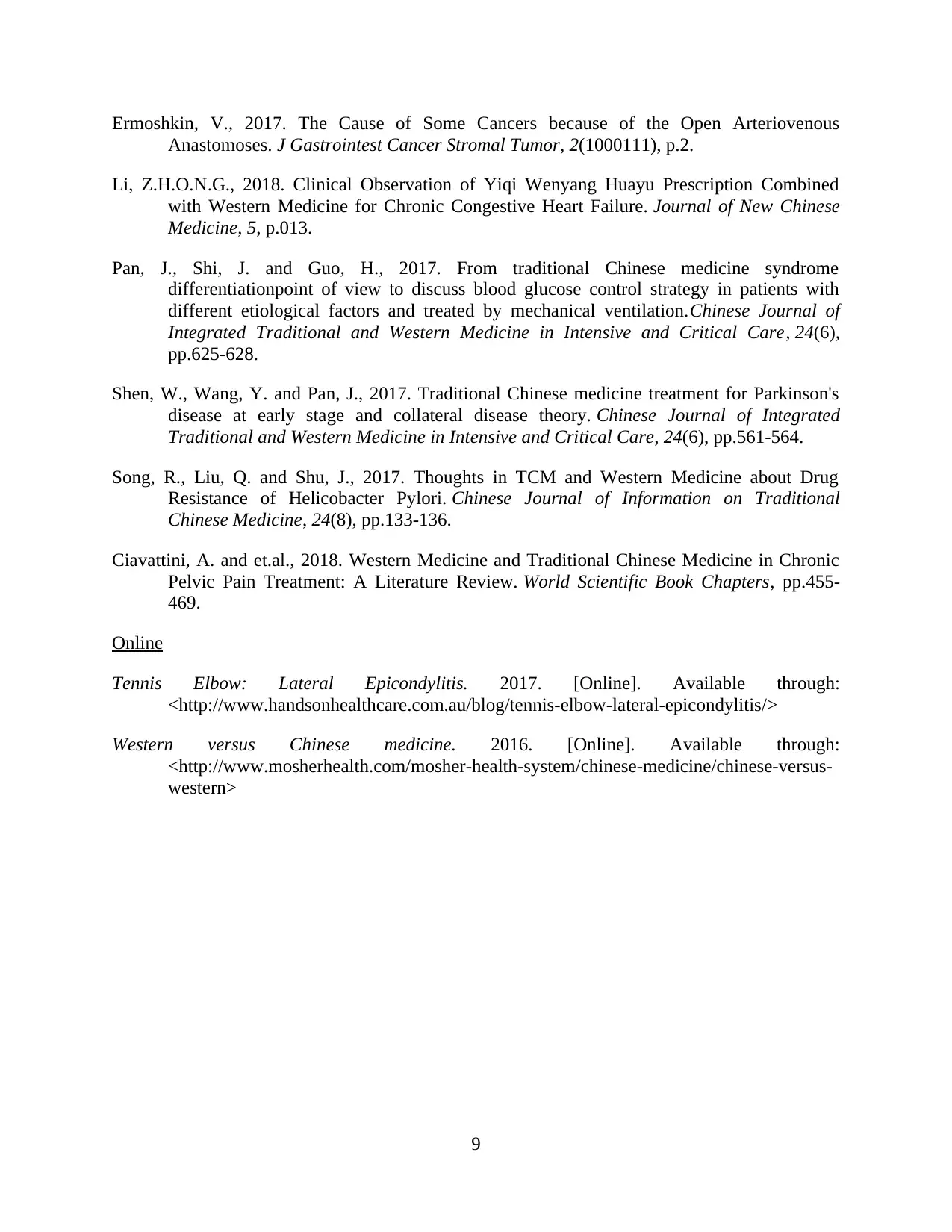
Ermoshkin, V., 2017. The Cause of Some Cancers because of the Open Arteriovenous
Anastomoses. J Gastrointest Cancer Stromal Tumor, 2(1000111), p.2.
Li, Z.H.O.N.G., 2018. Clinical Observation of Yiqi Wenyang Huayu Prescription Combined
with Western Medicine for Chronic Congestive Heart Failure. Journal of New Chinese
Medicine, 5, p.013.
Pan, J., Shi, J. and Guo, H., 2017. From traditional Chinese medicine syndrome
differentiationpoint of view to discuss blood glucose control strategy in patients with
different etiological factors and treated by mechanical ventilation.Chinese Journal of
Integrated Traditional and Western Medicine in Intensive and Critical Care, 24(6),
pp.625-628.
Shen, W., Wang, Y. and Pan, J., 2017. Traditional Chinese medicine treatment for Parkinson's
disease at early stage and collateral disease theory. Chinese Journal of Integrated
Traditional and Western Medicine in Intensive and Critical Care, 24(6), pp.561-564.
Song, R., Liu, Q. and Shu, J., 2017. Thoughts in TCM and Western Medicine about Drug
Resistance of Helicobacter Pylori. Chinese Journal of Information on Traditional
Chinese Medicine, 24(8), pp.133-136.
Ciavattini, A. and et.al., 2018. Western Medicine and Traditional Chinese Medicine in Chronic
Pelvic Pain Treatment: A Literature Review. World Scientific Book Chapters, pp.455-
469.
Online
Tennis Elbow: Lateral Epicondylitis. 2017. [Online]. Available through:
<http://www.handsonhealthcare.com.au/blog/tennis-elbow-lateral-epicondylitis/>
Western versus Chinese medicine. 2016. [Online]. Available through:
<http://www.mosherhealth.com/mosher-health-system/chinese-medicine/chinese-versus-
western>
9
Anastomoses. J Gastrointest Cancer Stromal Tumor, 2(1000111), p.2.
Li, Z.H.O.N.G., 2018. Clinical Observation of Yiqi Wenyang Huayu Prescription Combined
with Western Medicine for Chronic Congestive Heart Failure. Journal of New Chinese
Medicine, 5, p.013.
Pan, J., Shi, J. and Guo, H., 2017. From traditional Chinese medicine syndrome
differentiationpoint of view to discuss blood glucose control strategy in patients with
different etiological factors and treated by mechanical ventilation.Chinese Journal of
Integrated Traditional and Western Medicine in Intensive and Critical Care, 24(6),
pp.625-628.
Shen, W., Wang, Y. and Pan, J., 2017. Traditional Chinese medicine treatment for Parkinson's
disease at early stage and collateral disease theory. Chinese Journal of Integrated
Traditional and Western Medicine in Intensive and Critical Care, 24(6), pp.561-564.
Song, R., Liu, Q. and Shu, J., 2017. Thoughts in TCM and Western Medicine about Drug
Resistance of Helicobacter Pylori. Chinese Journal of Information on Traditional
Chinese Medicine, 24(8), pp.133-136.
Ciavattini, A. and et.al., 2018. Western Medicine and Traditional Chinese Medicine in Chronic
Pelvic Pain Treatment: A Literature Review. World Scientific Book Chapters, pp.455-
469.
Online
Tennis Elbow: Lateral Epicondylitis. 2017. [Online]. Available through:
<http://www.handsonhealthcare.com.au/blog/tennis-elbow-lateral-epicondylitis/>
Western versus Chinese medicine. 2016. [Online]. Available through:
<http://www.mosherhealth.com/mosher-health-system/chinese-medicine/chinese-versus-
western>
9
1 out of 11
Your All-in-One AI-Powered Toolkit for Academic Success.
+13062052269
info@desklib.com
Available 24*7 on WhatsApp / Email
![[object Object]](/_next/static/media/star-bottom.7253800d.svg)
Unlock your academic potential
Copyright © 2020–2025 A2Z Services. All Rights Reserved. Developed and managed by ZUCOL.

